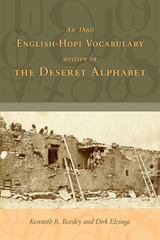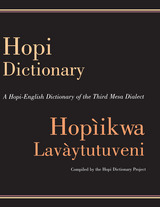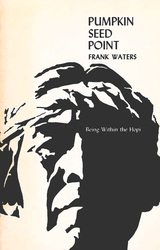3 books about Hopi

An 1860 English-Hopi Vocabulary Written in the Deseret Alphabet
Kenneth R. Beesley
University of Utah Press, 2014
In 1859 Brigham Young sent two Mormon missionaries to live among the Hopi, “reduce their dialect to a written language,” and then teach it to the Hopi so that they would be able to read the Book of Mormon in their own tongue. Young instructed the men to teach the Hopi to write in the Deseret Alphabet, a phonemic system that he was promoting in place of the traditional Latin alphabet. While the Deseret Alphabet faded out of use in just over twenty years, the manuscript penned in Deseret by one of the missionaries has remained in existence. For decades it sat unidentified in the Archives of the Church of Jesus Christ of the Latter-day Saints in Salt Lake Citya mystery document having no title, author, or date. But authors Beesley and Elzinga have now traced the manuscript’s origin to the missionaries of 1859-60 and decoded its Hopi-English vocabulary written in the short-lived Deseret Alphabet. The resulting book offers a fascinating mix of linguistics, Mormon history, and Native American studies.
The volume reproduces all 486 vocabulary entries of the original manuscript, presenting the Deseret and the modern English and Hopi translations. It explains the history of the Deseret Alphabet as well as that of the Mormon missions to the Hopi, while fleshing out the background of the two missionaries, Marion Jackson Shelton, who wrote the manuscript, and his companion, Thales Hastings Haskell. The book will be of interest to linguists, historians, ethnographers, and others who are curious about the unique combination of topics this work connects.
The volume reproduces all 486 vocabulary entries of the original manuscript, presenting the Deseret and the modern English and Hopi translations. It explains the history of the Deseret Alphabet as well as that of the Mormon missions to the Hopi, while fleshing out the background of the two missionaries, Marion Jackson Shelton, who wrote the manuscript, and his companion, Thales Hastings Haskell. The book will be of interest to linguists, historians, ethnographers, and others who are curious about the unique combination of topics this work connects.
[more]

Hopi Dictionary/Hopìikwa Lavàytutuveni
A Hopi-English Dictionary of the Third Mesa Dialect
Hopi Dictionary Project Hopi Dictionary Project
University of Arizona Press, 1998
Hopi culture has long received considerable attention from the outside world, but the Hopi language has remained much less well known. This is the first true dictionary of Hopi, containing approximately 30,000 entries. The dictionary is based on the dialect spoken today in villages on Third Mesa and was compiled in consultation with a large team of elder Hopi speakers. Its preparation has involved a comprehensive survey of the ethnographic and linguistic literature to identify Hopi vocabulary, and each item found has been checked against existing Third Mesa knowledge of Hopi. The dictionary is valuable not only for the number of its entries but also for its many illustrative sentences and its abundance of information on aspects of Hopi culture, such as often-misunderstood expressions concerning time and space. Main entries, presented for the simplest and most common forms of words, contain full information on inflection in addition to definitions and examples. Cross-references are made for inflected forms that are not easily predictable, such as plurals, less common variants, and combining forms. Many definitions are illustrated with line drawings. The volume also features an English-Hopi word-finder list and a sketch of Hopi grammar, which makes it possible for the user to determine the structure of almost any Hopi sentence. An invaluable reference in Uto-Aztecan languages, this dictionary permits informed reading of Hopi texts. It is a definitive source for understanding not only a language but also a way of life.
[more]

Pumpkin Seed Point
Being Within The Hopi
Frank Waters
Ohio University Press, 1973
Frank Waters lived for three years among the Hopi people of Arizona and was quickly drawn into their culture. Pumpkin Seed Point is a beautifully written personal account of Waters’s inner and outer experiences among the Hopi.
[more]
READERS
Browse our collection.
PUBLISHERS
See BiblioVault's publisher services.
STUDENT SERVICES
Files for college accessibility offices.
UChicago Accessibility Resources
home | accessibility | search | about | contact us
BiblioVault ® 2001 - 2024
The University of Chicago Press









